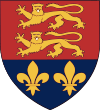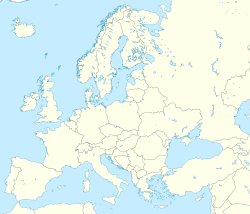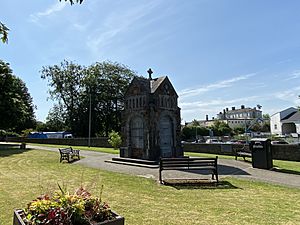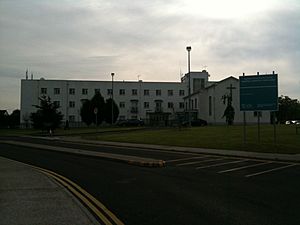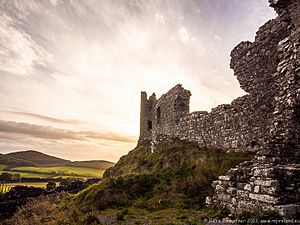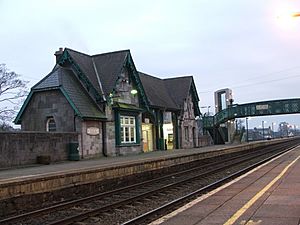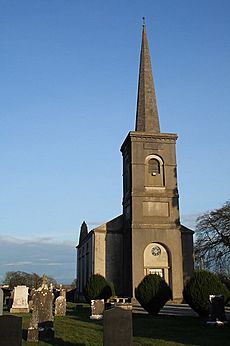Portlaoise facts for kids
Quick facts for kids
Portlaoise
Port Laoise
Maryborough
|
||
|---|---|---|
|
Main Street
St. Peter & Paul's Church
Portlaoise Courthouse
Portlaoise Prison
|
||
|
||
| Country | Ireland | |
| Province | Leinster | |
| County | Laois | |
| Founded | 1557 (as Maryborough) | |
| Town Charter | 1570 | |
| Area | ||
| • Total | 12.1 km2 (4.7 sq mi) | |
| Elevation | 139 m (456 ft) | |
| Population
(2022)
|
||
| • Total | 23,494 | |
| • Rank | 18th (1st in Midland) | |
| • Density | 1,941.7/km2 (5,029/sq mi) | |
| • Ethnic or cultural background |
List
|
|
| Time zone | UTC±0 (WET) | |
| • Summer (DST) | UTC+1 (IST) | |
| Eircode |
R32
|
|
| Area codes | 057 | |
Portlaoise (pronounced port-LEESH), also known as Port Laoise, is the main town of County Laois in Ireland. It is located in the South Midlands area, which is part of the province of Leinster.
Portlaoise was one of the fastest growing towns in Ireland between 2011 and 2016. The latest count in 2022 showed its population grew to 23,494 people. This makes it the biggest and most crowded town in the Midland Region.
The town was very important during the medieval period. It was the site of the Fort of Maryborough. This fort was built by English settlers in the 1500s. This happened during a time when England was settling parts of Ireland.
Portlaoise is surrounded by the Slieve Bloom Mountains to the west and north-west. To the east, there is a large area called the Great Heath of Maryborough. The town is known for its interesting buildings, engineering, and great transport links. It is about 94 kilometers (58 miles) southwest of Dublin on the M7. It is also well-connected to Cork and Limerick.
In the past, Portlaoise was famous for making things like iron and steel buildings. It also produced tennis balls, rubber seals, tires, and electrical cables. Ireland's first airplane was even made here! Today, Portlaoise is a busy business center. Its economy mostly relies on services. It is a key place for shopping, transport, and events for the areas around it.
Contents
History of Portlaoise
The name of the town, Port Laoighisi, was mentioned in old writings from the 1630s called the Annals of the Four Masters. The town we see today grew up around an old fort. This fort was known as "Fort of Leix" or "Fort Protector". You can still see parts of it in the town center.
Building the fort started in 1548. It was overseen by Sir Edward Bellingham, who was a powerful English leader. The fort was built to help England control the area. This happened after local Irish leaders had been sent away the year before. The fort was built on high ground. It was also protected by the River Triogue and a natural ridge. These features made it a very important place for defense.
The town itself was officially created by a law in 1557. This was during the time of Queen Mary. The early fort and its settlement had many names. These included Governor, Port Laois, Campa, and Fort Protector. But the new town was named Maryborough in honor of Queen Mary. The county was also named Queen's County after her. Around 1556, Portlaoise got its first church, Old St Peter's. It was first a Catholic church. But after Queen Elizabeth I became queen, it was used for Protestant services.
The area was a place of rebellion led by Ruairí Óg Ó Mórdha. He was a local Irish leader who had lost his lands. The English Crown wanted to settle these lands with loyal landowners. For about 50 years, the new English settlers in Maryborough fought small battles. They fought against the Irish leaders who resisted the new settlement. The town was burned down several times by the end of the 1500s.
Maryborough was allowed to have a market in 1567. Then, in 1570, Queen Elizabeth I gave the town a special document called a charter. This made the town a "borough". This meant it could have its own local government. This government included a mayor (called a burgomaster), two bailiffs, and other officers. Maryborough was represented by two members in the Parliament of Ireland until 1800. After that, it became part of Queen's County's voting area until 1922. The town's local government lasted until 1830.
In the early 1800s, a new Church of Ireland church was built. It replaced the older St Peter's church. This new church was the first building on the new Market Square. It is thought to have been designed by the famous architect James Gandon. Other important buildings built in Maryborough in the 1800s include the Court House (1805). The County Gaol (prison) was built in 1830. The large St. Fintan's Hospital was built in 1833.
The city of Maryborough, Victoria in Australia was named in the 1850s. It was named by James Daly, a gold official, after his birthplace in Ireland.
In 1929, after Ireland became independent, the town was renamed Portlaoighise. This was later simplified to Port Laoise. The county was also renamed County Laois.
Population and Growth
| Historical population | ||
|---|---|---|
| Year | Pop. | ±% |
| 1821 | 2,677 | — |
| 1831 | 3,223 | +20.4% |
| 1841 | 3,633 | +12.7% |
| 1851 | 2,078 | −42.8% |
| 1861 | 2,935 | +41.2% |
| 1871 | 2,731 | −7.0% |
| 1881 | 2,872 | +5.2% |
| 1891 | 2,809 | −2.2% |
| 1901 | 2,957 | +5.3% |
| 1911 | 3,270 | +10.6% |
| 1926 | 3,374 | +3.2% |
| 1936 | 3,396 | +0.7% |
| 1946 | 3,170 | −6.7% |
| 1951 | 3,304 | +4.2% |
| 1956 | 5,561 | +68.3% |
| 1961 | 5,598 | +0.7% |
| 1966 | 5,873 | +4.9% |
| 1971 | 6,470 | +10.2% |
| 1981 | 7,756 | +19.9% |
| 1986 | 8,384 | +8.1% |
| 1991 | 8,360 | −0.3% |
| 1996 | 9,474 | +13.3% |
| 2002 | 12,127 | +28.0% |
| 2006 | 14,613 | +20.5% |
| 2011 | 20,145 | +37.9% |
| 2016 | 22,050 | +9.5% |
| 2022 | 23,494 | +6.5% |
Portlaoise was one of Ireland's fastest growing towns from 2006 to 2011. Its population increased by almost 38%. In the 2016 count, it was still among the top 10 fastest growing areas. The population of the town and its nearby areas went over 22,000. By the 2022 count, the population reached 23,494 people.
In 2022, about 28% of the people in Portlaoise were from other countries. This is higher than the national average of 20%. The largest group was Polish people. Other large groups were from other European Union countries and the rest of the world. The former Mayor, Rotimi Adebari, was the first person of African background to become a mayor in Ireland.
Because the population has grown so quickly, Portlaoise has added many new services. These include a new fire station and a large swimming and leisure center. Portlaoise also has many young people under 15. This has led to the building of new secondary and primary schools.
Economy and Business
Portlaoise has always been a big center for business and shopping in the Midlands. In the past, the town's main industries were making flour and woolen fabric. Now, some of the biggest employers are government-owned groups. These include the high-security Portlaoise Prison and the Midlands Prison. The Department of Agriculture and the Midland Regional Hospital, Portlaoise also employ many people.
Other major employers are state-owned companies like Córas Iompair Éireann (trains). They have a train maintenance center in Portlaoise. The ESB (electricity company) has a training center here. An Post (the postal service) is also a big employer. In 2013, a new system called MyPay was set up in Portlaoise. It handles the pay for 55,000 local government workers across Ireland.
Because of its location and good transport links, Portlaoise was chosen for Ireland's first "Inland Port". This means the town is encouraged to grow in areas like distribution, logistics, and warehousing. An Post runs the second largest mail center in Ireland here, after Dublin.
Shopping Areas
Portlaoise has many places to shop. These include Laois Shopping Centre, which has Tesco. The Kyle Centre has Dunnes Stores. Parkside Shopping Centre has Super Valu. There are also retail parks with stores like Aldi, Lidl, and Shaws department stores.
Tourist Attractions
There are several interesting places to visit near Portlaoise. The Rock of Dunamase is about 6 kilometers (3.7 miles) east of town. It is a castle on a hilltop that dates back to the 1100s. There is also a 12th-century round tower about 12 kilometers (7.5 miles) away in Timahoe.
Another nearby site is Fort Protector. This 16th-century fort was built to protect early British settlers.
Emo Court is a large, beautiful estate with a Georgian-style house. It was designed by James Gandon and is located in nearby Emo.
Transport Connections
Portlaoise is located at a major crossroads for Irish roads. Major roads to Dublin, Limerick, and Cork pass through or near it. In the 1990s, the M7 motorway was built to go around the town. This has helped reduce traffic in the town center.
Portlaoise railway station is one of the busiest train stations outside of Dublin. It has intercity trains that go between Dublin and Cork. It also has Dublin commuter trains. The Maryborough railway station opened on June 26, 1847. It is the end point for the Portlaoise Commuter Service. This service stops at all stations to Heuston in Dublin. It runs hourly during off-peak times and every 20-30 minutes during busy times. It is the busiest county town train station in the Midland Region. It has many trains to and from Dublin every day. Córas Iompair Éireann opened a train depot southwest of Portlaoise in 2008. This facility maintains and services many new intercity and suburban trains.
Bus Éireann used to run intercity bus services that stopped in Portlaoise. However, these services were stopped in 2020. There is still one Bus Éireann service, route 73, that stops in Portlaoise. It travels from Athlone to Waterford. Other bus services are provided by JJ Kavanagh and Sons and TFI Local Link. These connect Portlaoise to places like Limerick, Roscrea, Cashel, Thurles, and Birr. There is also a local town link service that connects to nearby villages.
Dublin Coach also runs services from Dublin to Portlaoise.
The Stradbally Steam Museum is in nearby Stradbally. It is all about steam engines. It has a large collection of steam engines, including old carts and tractors. The museum shows how transport used to be in Portlaoise and Ireland. The Steam Preservation Society has a 1-kilometer (0.6-mile) train track. It is on the grounds of Stradbally Hall and offers rides for train fans.
Aviation History
Portlaoise is known as the birthplace of aviation in Ireland. The first airplane made in Ireland was put together in the town. It was built by Frank & Louis Aldritt, William Rogers, and John Conroy. The King's County Chronicle reported its first flight on November 4, 1909. The plane was stored during World War I. It stayed in storage for over 50 years until Joe Rogers found it. Joe was the son of William Rogers, one of the original builders. He found it in an English museum. The plane was eventually brought back to Portlaoise and has been restored.
Culture and Community Life
Nightlife and Entertainment
Portlaoise is located right in the middle of Ireland. It has many restaurants, pubs, bars, and nightclubs around Market Square and Main Street. There are also other fun activities nearby like paintball, golf, and bowling. This makes it a popular place for weekend trips and parties. Portlaoise railway station is the closest station to Stradbally Hall. This is where the Electric Picnic Festival is held every year.
Arts and Festivals
Every year, Portlaoise hosts several festivals. The Old Fort Quarter Festival takes place in June. The Halloween Howls Comedy Festival is held on the October bank holiday weekend. The Leaves Literary Festival happens in November.
The Dunamaise Arts Centre is a place for movies, performances, and art shows. It is located in the building that used to be the Maryborough Gaol (prison). The Arts Centre opened in 1999. Its opening helped bring back the Laois Drama Group.
The "Old Fort Festival" is an annual event. Since 2019, it has been held within the walls of the old Fort Protector. This fort was built between 1547 and 1548. It was the first of its kind in Ireland. The festival celebrates the town's history.
The Stradbally Steam Rally is an annual event. It takes place on the August bank holiday weekend at Stradbally Hall. It attracts visitors from all over Ireland. It is a major event for people who love steam engines.
The All-Ireland Scarecrow Festival is held in Durrow each year in late July. It features large scarecrows that look like famous figures or scenes. Local groups, children, and businesses make these scarecrows.
Charity Work
Since 2008, Portlaoise has been the Irish home of Self Help Africa. This organization helps with rural development programs in Sub-Sahara Africa. It was started during the Ethiopian Famine of 1984. It is the chosen charity of the Irish Farmers Association.
Sports Activities
Portlaoise has several sports clubs. Portlaoise RFC is a local rugby club located outside the town at Togher. Portlaoise GAA is the local Gaelic Athletic Association club. It is the most successful GAA club in Leinster. Other local sports clubs include Portlaoise Association Football Club and Portlaoise Senior Basketball Club.
Sporting facilities in the area include Portlaoise Leisure Centre. It has a 25-meter (82-foot) swimming pool, a gym, and pitches for soccer. There is also a skate park. Portlaoise Golf Club has an 18-hole course on the Abbeyleix Road.
Portlaoise AFC (Association Football Club) is located on the Mountmellick road in Rossleighan Park.
Education in Portlaoise
Portlaoise College is a secondary school located close to the town center. It provides full-time education for over 300 students. Students can study for their Junior and Leaving Certificates here.
Portlaoise Institute offers further education courses. These include QQI Level 5 and 6 Courses. They cover subjects like beauty therapy, hairdressing, healthcare, nursing, business studies, information technology, and sports management.
Famous People from Portlaoise
Many notable people have come from Portlaoise:
- Damien Bowe – a singer and former member of the Irish boyband D-Side.
- Pat Boran – a poet and radio presenter.
- Anne Keenan-Buckley (born 1962) – a middle-distance runner who was on the Irish team for the 1988 Summer Olympics.
- Pat Critchley – a GAA player who excelled in both Gaelic football and hurling.
- TJ Doheny – a professional boxer and former IBF World Super Bantamweight Title holder.
- James Fitzmaurice – a pioneer in aviation.
- Stephen Hunt – an association football player, born in Portlaoise in 1981.
- Arthur Jacob – a Professor of Anatomy who specialized in ophthalmology (eye care).
- Pádraig Mac Lógáin – the only person to be President of Sinn Féin twice. He owned a pub on Main Street.
- Eoghan Masterson – a professional rugby player for Connacht.
- Alison Miller – a professional rugby player.
- Bartholomew Mosse – the founder of the Rotunda Hospital in Dublin.
- Sean O'Rourke – an RTÉ journalist and broadcaster.
- Colm Parkinson – a retired Gaelic footballer and journalist.
- Brian Rigney (born 1963) – an Irish former rugby union player who played for his country.
- Robert Sheehan – an actor known for shows like Misfits, Love/Hate, and The Umbrella Academy.
- Zach Tuohy – an Australian Football League premiership player.
|
See also
 In Spanish: Portlaoise para niños
In Spanish: Portlaoise para niños






